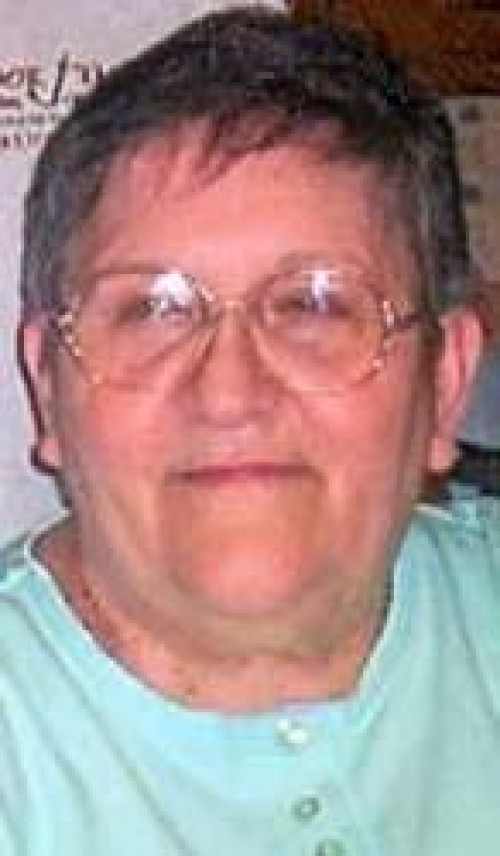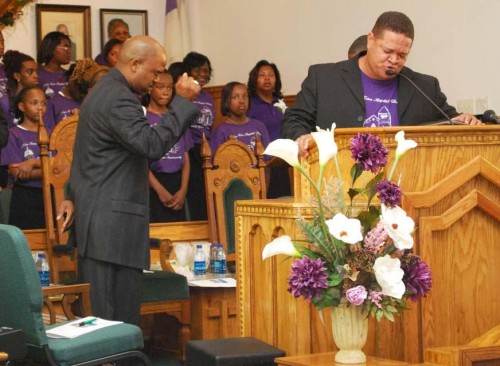March 17
March 17, 2009
Loyce "Lois" H. Matherne
March 19, 2009Near the intersection of Louisiana Highway 24 and Grand Caillou Road in Houma stands the New Zion Baptist Church.
From the exterior, it may look like a simple house of worship. But in its foundation lies the historical progress of blacks in Terrebonne Parish.
New Zion is the oldest black Baptist church in the parish. On March 8, New Zion commemorated its 150th year anniversary. It was the culmination of a week of celebration services held at the church.
“This is not just a church anniversary, it’s an anniversary for Terrebonne Parish as well,” said Rev. Haywood Sims Jr., fifth-year pastor at New Zion. “It means a lot because this is where it all started. The majority of all Baptist churches in Terrebonne Parish started with members from New Zion. That’s why we call it the ‘Mother Church.'”
Many of the 300-member congregation dressed in the church colors, purple and white, for the anniversary service.
The “Fire on Grand Caillou,” as members like to refer to New Zion, added more spice to the festivities by inviting the Rev. Vernon C. King, nephew of Dr. Martin Luther King Jr., as the guest speaker.
“It was a wonderful celebration. I was grateful to help celebrate a milestone like this,” King said. “One hundred fifty years is a blessing. It’s a testament to this church’s commitment to the Lord’s work.”
New Zion has been instrumental in starting most of the first black church and social services in Terrebonne Parish – Women’s Day, Men’s Day and Homecoming.
The building adjacent to the church, currently a Fellowship Hall, housed Terrebonne Parish’s first kindergarten for black children in 1950.
Across Grand Caillou Road from New Zion is the church cemetery, which has over 700 tombs. Some graves date all the way back to the early 1800s.
Many currently in the congregation can trace their family tree to the early years of the church.
“I have been here 42 years, and my niece is currently the sixth generation brought up in New Zion,” said Gary Williams, a sergeant with the Louisiana State Police Troop C Bureau of Investigation. “We have other families that have four, five, six generations that have been in this church.”
There have been only 10 pastors in the 150 years of New Zion Baptist Church, beginning with its founder, the Rev. Isaiah Lawson.
According to church historian Carlton Stokes, Lawson was a freed Negro from the North. He could read and write, so he was either taught by his former master or by another freed Negro. Lawson migrated from the North and settled in Terrebonne Parish.
The land on which New Zion is built was donated by Robert Ruffin Barrow, a sugarcane plantation owner and canal operator originally from North Carolina.
Barrow owned six plantations in Terrebonne Parish including Residence, which is half a mile from the church.
The relationship between Lawson and Barrow is unknown. Although legally the land was not donated until April 21, 1873, Lawson, along with other freed Negroes and slaves, constructed the initial church from 1858-59. When it was completed, the church was originally called Little Zion Baptist Church.
“So for 14 years, this church was worshiping God, probably on a plantation or in the residences of some of its members,” Stokes said.
The only part of the original church still in existence is the brick foundation. That foundation evidences the quality of craftsmen the original church builders were.
“We noticed some of the bricks had begun cracking, so I called the guy from Cable Lock to see if the church is sinking,” Sims recalled. “He said, ‘Whoever put this together knew what they were doing. The church ain’t sinking.’ The bricks are attached. The brick may be sinking but the church ain’t going nowhere. We’re on a sound foundation.”
While the sprit of the church has remained constant, many other aspects have changed. For example, the first church baptismal pool was Bayou Terrebonne.
Senior deacon Henry Rockward Sr., a 69-year member of the church, can recollect his own baptism at age 8.
“It was just like carnival,” Rockward said. “When people found out there was a baptism, they lined both sides of the street. The deaconesses put the young ladies into long white gowns and the young men into white pants and a white shirt. When they got ready to baptize them, they tied their legs. I don’t know why they did that. When they finished the baptism, everybody came back here and they didn’t let you eat that day.”
The church has been remodeled three times. When it was remodeled in 1912, the named changed to New Zion. The last remodeling was in 1968.
New Zion applied to the National Register of Historic Places for federal funds to do interior remodeling in the 1990s. However, they were rejected because the original structure no longer existed.
“If we hadn’t done that before 1968, this would have been a National Historic Site in Terrebonne Parish,” Williams said.
In 2006-07, the church raised enough money to do a complete interior renovation of the church.
One of the major reasons for New Zion’s growth, according to church officials, is its long history of stressing education to its youngest members.
“Each generation of young folks has been better educated and they can go out and reach the people,” Rockward said. “We’re growing in spirit and in mind.”
Two of the church’s pastors, the Revs. Forest Danks and Wilbert J. Danks, were educators as well as ministers.
Forest Danks lived in Deweyville and taught school in his house, Stokes said.
Danks would sit the children on his L-shaped porch and go from group to group teaching the children.
“The Intracoastal Canal and the tunnel had not been dug back then. So the children would have to get to Deweyville by walking across a big cow pasture,” Stokes explained. “The big kids would hold up the barbwire fence for the little kids to cross through to get to school.”
Wilbert Danks was appointed church pastor in 1947. It was under his tenure that the congregation opened the first black kindergarten.
Today, the church membership and their offspring run the entire socio-economic ladder, including prominent upper-middle positions.
Willie Rockward, nephew of Henry Rockward, is a minister and assistant professor of physics at Morehouse College in Atlanta. Ivan Daggs, son of church member Emma Daggs, is the first black judge from Terrebonne Parish. Besides being a city judge in Grambling, he’s an attorney and professor of law at Grambling State University.
“Our congregation runs the gamut, ” Williams said. “We have two principals, several schoolteachers, attorney Linda Mitchell, Dana Coleman, chief of detectives for the Houma Police Department. We have homeless people from the Bunk House who come in all the time and give testimonials.”
Sims would like to include the Bunk House shelter in New Zion’s ambitious plan to provide more social services in the community.
“We want to own this whole block. Basically call it Zion City,” Sims said. “We’re going to have an educational building for tutoring. We want to reopen the daycare center. We want to own the Bunk House and give those people who stay there some stability. We have one member who stays at the Bunk House. We don’t own it yet, but we will.”
That would be quite an achievement for a church that rose from a plantation in pre-Civil War Terrebonne Parish.
As New Zion Baptist Church celebrates its sesquicentennial anniversary, Sims and other church members reflect humbly on the obstacles their ancestors overcame to worship in peace. Just as important, they have a clear vision of what possibilities lay ahead for them.
“I’m loving this because I am a part of that history,” Sims said. “It feels good to be a part of history and to keep it rolling because, as you can see, we’re not going nowhere anytime soon. The Lord is blessing us above and beyond.”
Sgt. Gary Williams reads the scripture during the New Zion Baptist Church 150th Anniversary service. Many believe the land donated to build the church was part of Residence Plantation, located half a mile from New Zion. * Photo by KEYON K. JEFF














